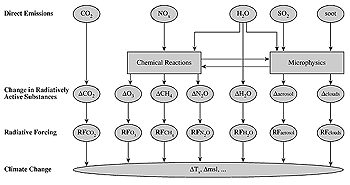|
6.1. How Do Aircraft Cause Climate Change?
|

Figure 6-1: Schematic of possible
mechanisms whereby
aircraft emissions impact climate. Climate impact is
represented by changes in global mean surface
temperature (≥Ts) and global mean sea level rise (≥msl).
|
Aircraft perturb the atmosphere by changing background levels of trace
gases and particles and by forming condensation trails (contrails).
Aircraft emissions include greenhouse gases such as CO2
and H2O that trap terrestrial radiation and chemically
active gases that alter natural greenhouse gases, such as O3
and CH4. Particles may directly interact with
the Earth's radiation balance or influence the formation and radiative
properties of clouds. Figure 6-1 portrays
a causal chain whereby the direct emissions of aircraft accumulate in
the atmosphere, change the chemistry and the microphysics, and alter
radiatively active substances in the atmosphere, which change radiative
forcing and hence the climate.
Chapters 2 and 3 link the
direct emissions of aircraft today to changes in radiatively active
substances, and Chapter 4 projects these atmospheric
changes into the future for a range of aviation scenarios. This chapter
presents calculations of radiative forcing from aircraft-related atmospheric
changes and discusses implications concerning the role of aircraft in
a changing climate. This section begins with the concept of "dangerous
climate change," as defined within the mandate of the United Nations
Framework Convention on Climate Change (FCCC), then presents the IS92
scenarios for future climate change associated with the Second Assessment
Report (IPCC, 1996). Section 6.1 also summarizes
aviation's potential role in climate change and its proportion of fossil
fuel use. Section 6.2 discusses the concepts of
radiative forcing (RF) and global warming potential (GWP). Section
6.3 provides calculations of radiative forcing from aircraft perturbation
of greenhouse gases, and Section 6.4 presents
calculations of RF from aircraft perturbations of aerosols and contrails.
Section 6.5 examines how radiative forcing can
be used as a predictor of climate change and presents some case studies
of climate change patterns that might be induced by aviation. Finally,
Section 6.6 presents the summed radiative forcing,
and associated climate change, for a range of projected scenarios and
technological options in future aviation.
|